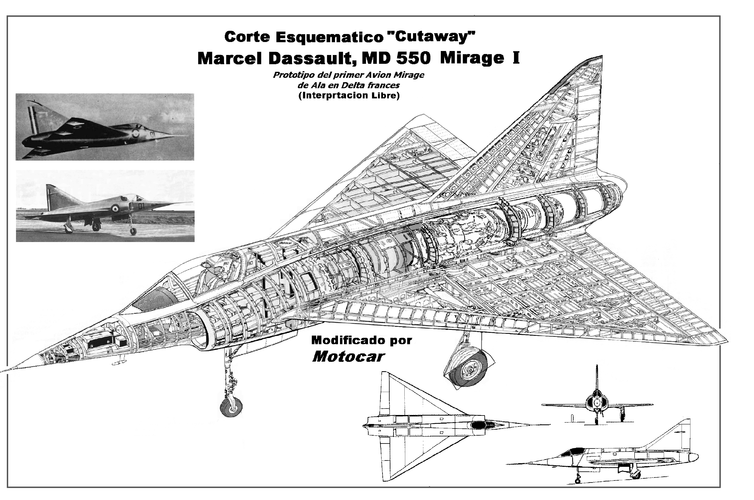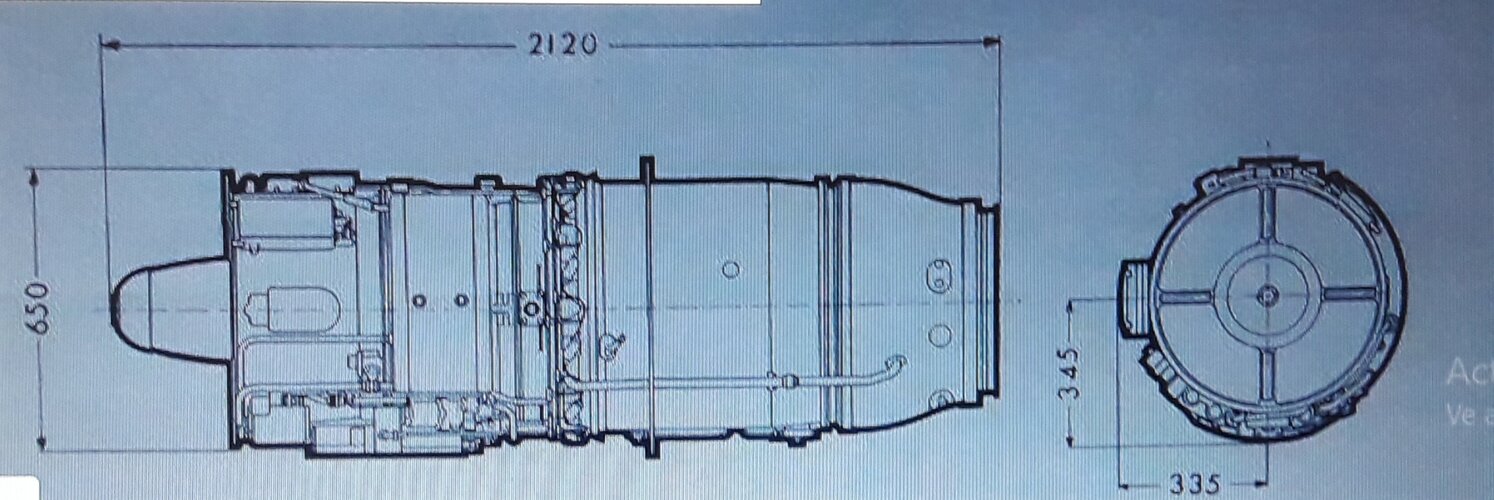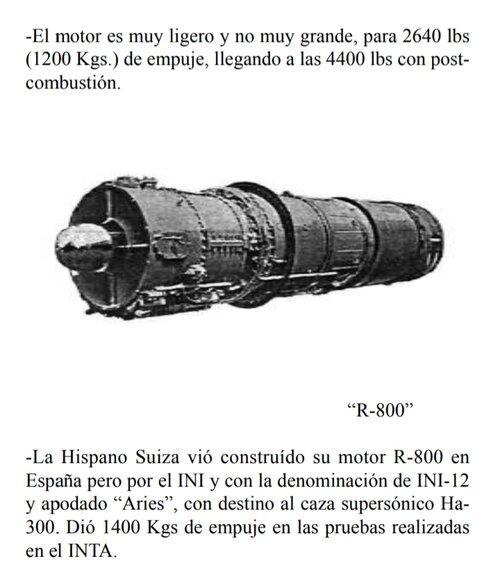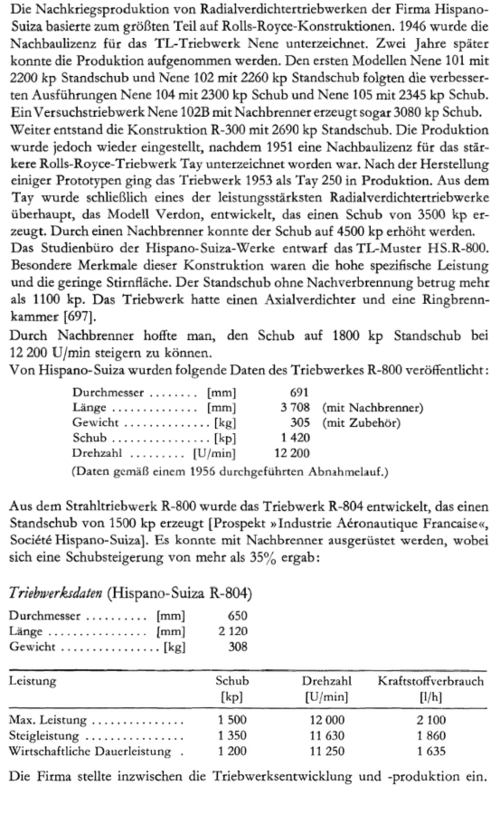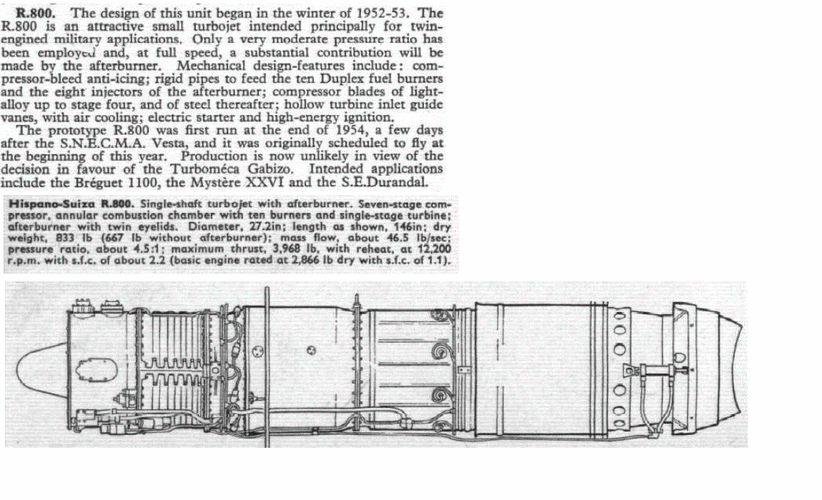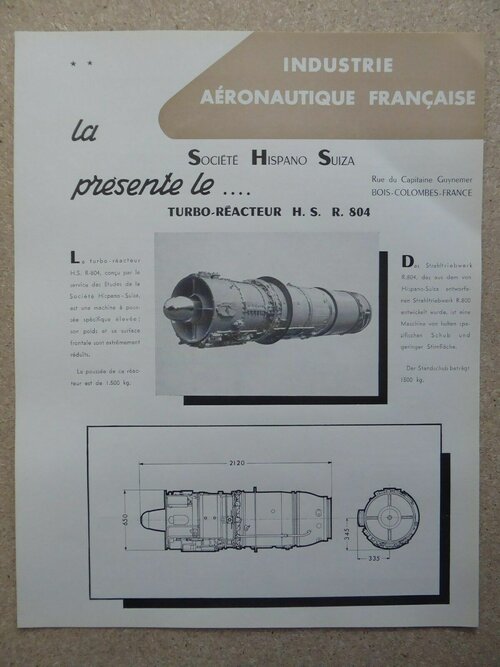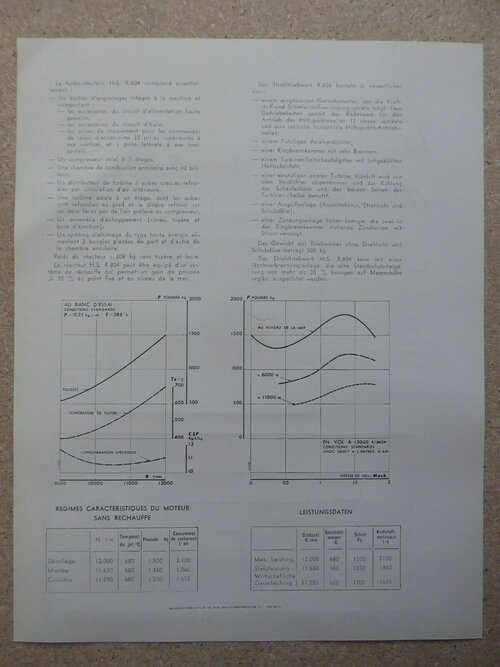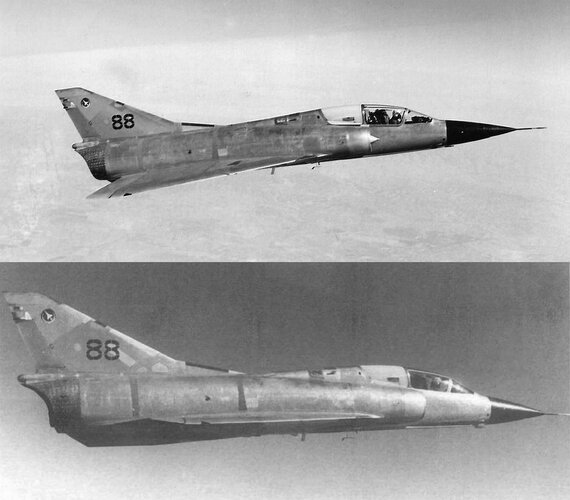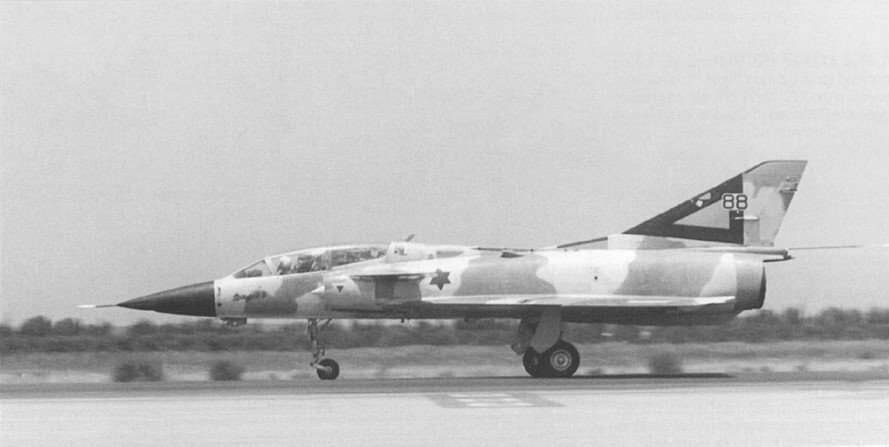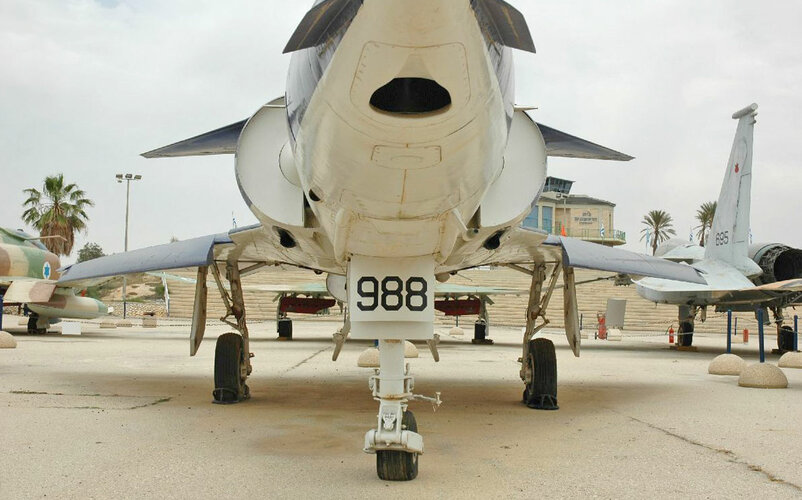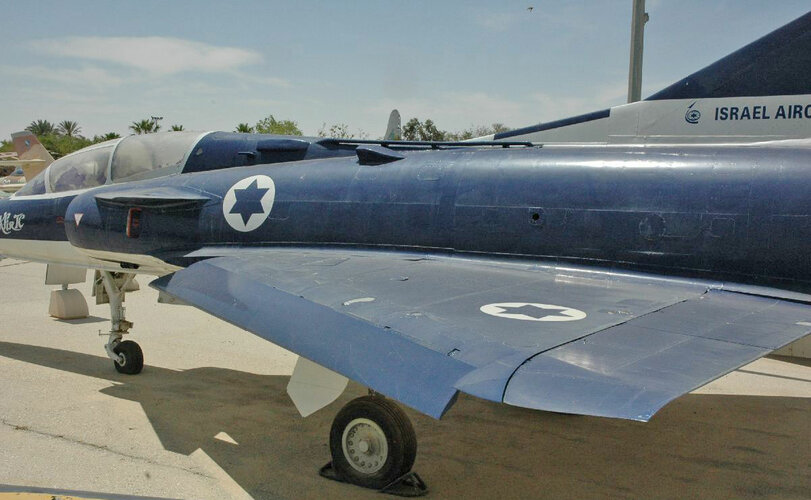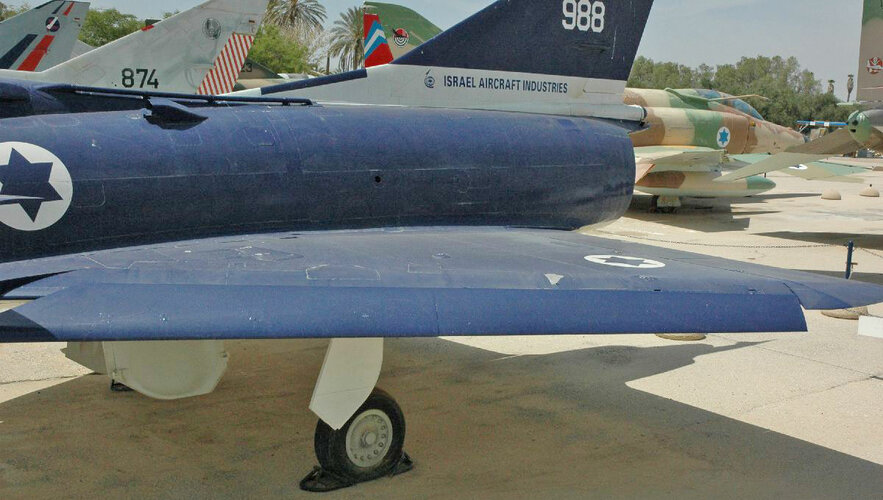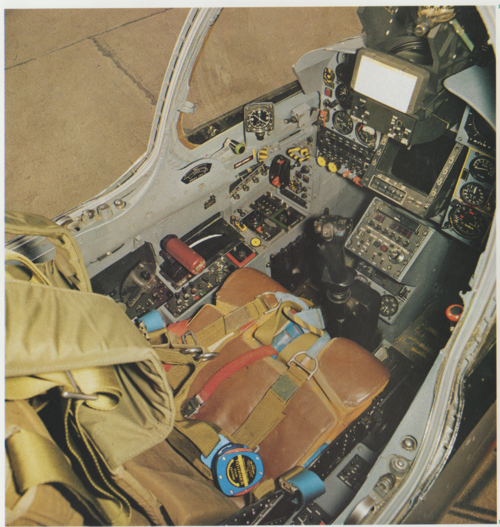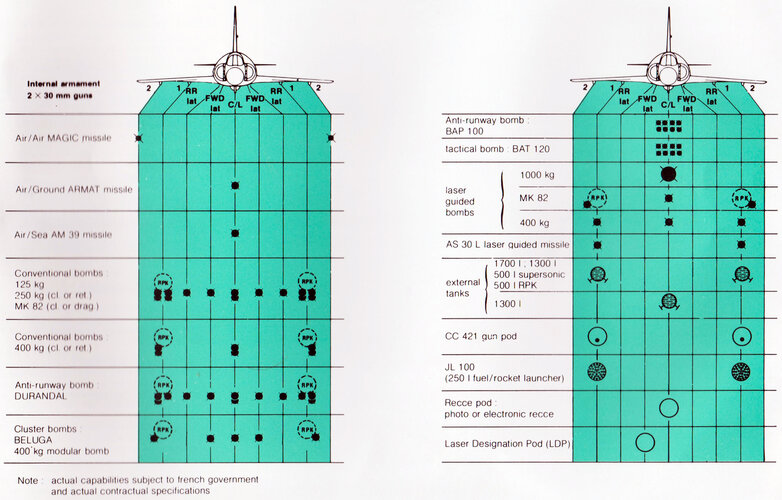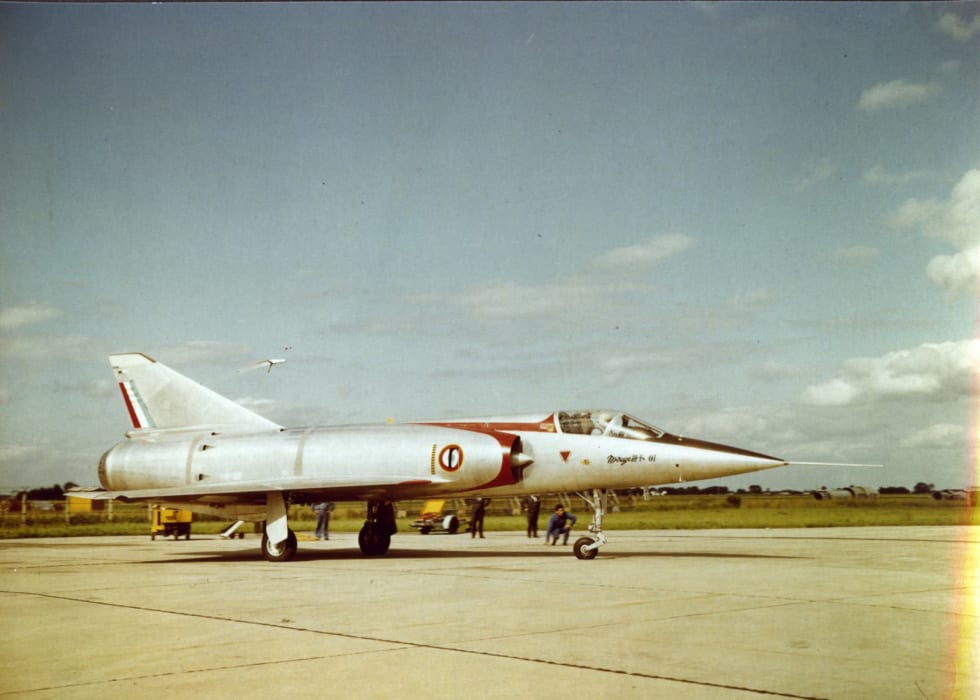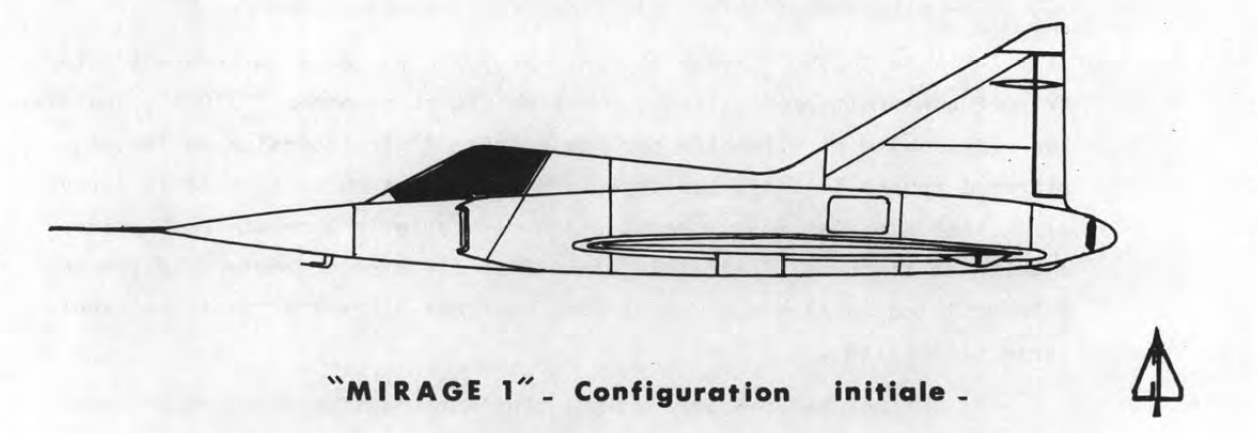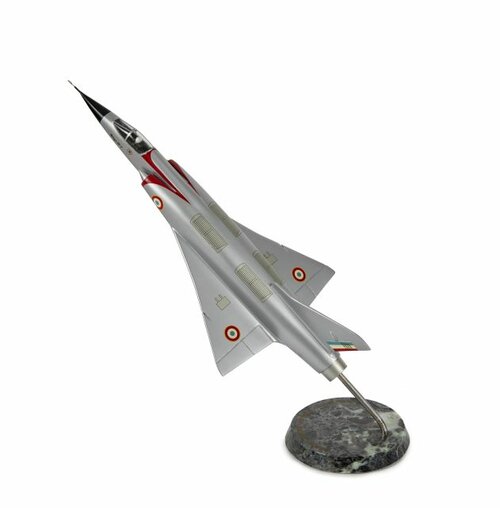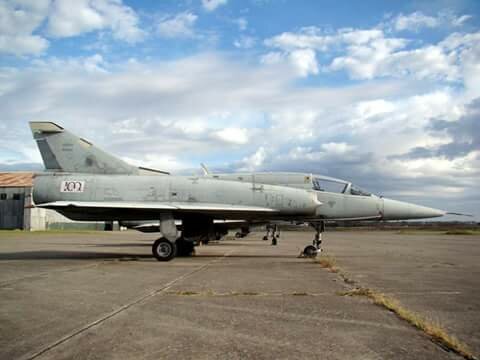You are using an out of date browser. It may not display this or other websites correctly.
You should upgrade or use an alternative browser.
You should upgrade or use an alternative browser.
Mirages I - III/5, Prototypes & Projects
- Thread starter Archibald
- Start date
The data I have is somewhat confusing and contradictory. A prototype of the R-800 was built in Spain with the name INI-12 and its characteristics are as follows:Interesting..there is a lack of info out there on this R-800.
Is there a brief overview or info about its thrust, dimensions, and which aircraft it was aimed at?
I can't translate the text well, but it seems to mention the Mirage III.
Do they mean the original smaller Mirage III as envisaged, opposed to the larger version of the Mirage III that was productionised as the IIIA and IIIC?
Length: 3.708mm with afterburner
Diameter: 691mm
Weight: 305kg
Projected power: 1.200kg
Projected power with afterburner: 1.995kg
Power un tests: 1.400kg
Features of the R-804:
Length: 2.120mm
Diameter: 650mm
Weight: 308kg
Projected power: 1.500kg
Projected power with afterburn: 2.025kg
Image. R-804:
Attachments
@Toryu Whats the confusion? The “Les Ailes” magazine article I posted earlier has all the details and confirms that the R-804 data above is correct: L=2.120m, T= 1,500kg dry, W=308kg dry, 360-370kg installed.
With the afterburner this increases to L=3.702m, T= 2,025kg wet, W=420-430kg installed.
The early R-800 was rated at a lower 1,200kg thrust dry, but had the same dimensions as the R-804.
With the afterburner this increases to L=3.702m, T= 2,025kg wet, W=420-430kg installed.
The early R-800 was rated at a lower 1,200kg thrust dry, but had the same dimensions as the R-804.
Your data on the R-804 coincide with mine and the dimensions also coincide with the plan that I have uploaded. But according to a Spanish publication the INI-12 (R-800) gave 1,400kg in tests instead of the 1,200 projected. Another doubt that I have is that the sectional image of the R-804 actually corresponds to the R-800 since it does not look like the plane I have uploaded.
Attachments
Another doubt that I have is that the sectional image of the R-804 actually corresponds to the R-800 since it does not look like the plane I have uploaded
The French article in “Les Ailes” has the same picture. The caption says that this is the R-854 (R-804 with reheat). So that should explain why the engine looks longer in this picture.
- Joined
- 28 November 2006
- Messages
- 711
- Reaction score
- 734
Here you've got some info on the Hispano-Suiza R800-series jet engines that I've found in my files.
From "Hispano Suiza in Aeronautics. Men, Companies, Engines and Aircraft" by Manuel Lage:
Below you'll find attached a cut-out from that book with the engines' data.
The book contains also info on the Spanish INI jet engines. What is said in the book is there were two INI engine projects: the INI-11 Aries (a derivative of the Heinkel HeS-011) that was to have 1400 kp thrust and the INI-12 (apparently NOT a version of the R800) with projected thrust of 2400 kp.
Moreovert you've got cut-outs from "Enzyklopädische Abhandlung über ausgeführte Strahltriebwerke" by Karl Leist (published in 1963) and from the "Flight" magazine (sorry, I don't know now which issue it come from).
Specs according to the "Flight" are as follows (in metric units):
diameter 690 mm
length 3708 mm (with afterburner)
weight 302 kg (377 kg with afterburner)
thrust 1300 kp (1800 kp with afterburner)
And finally two pages form an advertisment/brochure on the R804 engine
Piotr
From "Hispano Suiza in Aeronautics. Men, Companies, Engines and Aircraft" by Manuel Lage:
The New Hispano Suiza R-800 Turbojet Engine
In 1953, the Ministère de l'Air launched a program for the future tactical light fighter aircraft that required a 1000-kg thrust jet engine. The dimension characteristics for the project required the use of an axial flow compressor instead of a centrifugal one, a technological field in which Hispano Suiza had hardly any experience. For that reason, the company signed an agreement with Rolls-Royce to test the compressors on its bench because Hispano Suiza did not have the necessary technical testing means.
Tests of the first Hispano Suiza R-800 prototype, the first design of a jet engine totally by Hispano Suiza, started early in 1955, with a thrust of 1200 kg recorded. In 1956, a 10-hour contract test was conducted successfully at 1420 kg thrust. One year later, in March 1957, the definitive R-804 version with 1500 kg thrust was approved. The development of the R-804 jet engine thus was finished and ready for series production. However, in those months, a strategic change was made at the Ministère de l'Air, which would force Hispano Suiza to redefine its future.
In 1956, the ministry told Hispano Suiza that in the future, no further contracts for jet engines would be granted. All such contracts would be granted to SNECMA, a national company whose corporate purpose was that type of products, which had now reached maturity. On the other hand, the Turboméca Gabizo engine was chosen for the project of the light fighter for which the R-804 was intended. The SNECMA Vesta also was dismissed. The light fighter program was cancelled in 1958, and the Gabizo engine was never built in series.
After the important announcement that Hispano Suiza ceased to be a supplier of French military engines, President Maurice Heurteux took the decision to continue the development of the R-804 engine at the company's own expense, with two new versions envisaged: the R-854 with afterburning and 2000 kg thrust, and a 2200-kg civilian version. None of these projects saw the light of day because of a lack of commercial guarantee, with extremely high development costs.
Below you'll find attached a cut-out from that book with the engines' data.
The book contains also info on the Spanish INI jet engines. What is said in the book is there were two INI engine projects: the INI-11 Aries (a derivative of the Heinkel HeS-011) that was to have 1400 kp thrust and the INI-12 (apparently NOT a version of the R800) with projected thrust of 2400 kp.
The initial turbojet program also made consideration of another jet engine to be developed later, the INI-12. With a seven-stage compressor (similar to the French ATAR), it should have afforded 2400 kg thrust.
It is curious that the Spanish INI-Aries jet engine afforded a power rating that was similar to that of the Hispano Suiza R-800 jet engine, the first jet engine to be wholly designed by the company in France in the same period.
Moreovert you've got cut-outs from "Enzyklopädische Abhandlung über ausgeführte Strahltriebwerke" by Karl Leist (published in 1963) and from the "Flight" magazine (sorry, I don't know now which issue it come from).
Specs according to the "Flight" are as follows (in metric units):
diameter 690 mm
length 3708 mm (with afterburner)
weight 302 kg (377 kg with afterburner)
thrust 1300 kp (1800 kp with afterburner)
And finally two pages form an advertisment/brochure on the R804 engine
Piotr
Attachments
- Joined
- 9 October 2009
- Messages
- 21,973
- Reaction score
- 13,620
From April 6th:

 elpoderdelasgalaxias.wordpress.com
elpoderdelasgalaxias.wordpress.com

Dassault Mirage IIIE: Joyeux Anniversaire.
The first E made its first flight 60 years ago yesterday. Not as pure as the C, this multirole variant added some muscle to an already capable design. Here a French AF IIIE in its anti-radar config…
- Joined
- 27 March 2006
- Messages
- 1,873
- Reaction score
- 1,619
It really is amazing how this aircraft developed, into a myriad of versions, with later related airframe, avionic, and weapons developments much beefier, advanced, and so different.
A truly great design
A truly great design
D
Deleted member 2278
Guest
Brazil were apparently interested in IAI re-engineing their Mirage IIIs with J79s but baulked on cost grounds:
No surprise. The J79 was always a tight fit for the Mirage rear end (no sexual innuendo here please, you perverted minds).
In fact I've just realized that (AFAIK) it was actually never done. Mirage IIIO did it for the Avon, but no such swap was ever done for the J79.
I mean, rolling a J79 in place of an Atar in a second-hand (not NEW BUILD) Mirage airframe.
Neshers were "pirate" Mirage Vs - but kept the Atar.
Kfir was a Mirage airframe derivate... but those airframes were fresh and new build.
And considering all the mods it took to roll a J79 inside the Kfir, including that small intake at the base of the fin...
At least it made the Kfir one hell of a hotroad, according to former F-21 DACT drivers. It seemingly accelerated like a freakkin' MiG-23, in fact it was one of the reasons they picked it for the job.
In fact I've just realized that (AFAIK) it was actually never done. Mirage IIIO did it for the Avon, but no such swap was ever done for the J79.
I mean, rolling a J79 in place of an Atar in a second-hand (not NEW BUILD) Mirage airframe.
Neshers were "pirate" Mirage Vs - but kept the Atar.
Kfir was a Mirage airframe derivate... but those airframes were fresh and new build.
And considering all the mods it took to roll a J79 inside the Kfir, including that small intake at the base of the fin...
At least it made the Kfir one hell of a hotroad, according to former F-21 DACT drivers. It seemingly accelerated like a freakkin' MiG-23, in fact it was one of the reasons they picked it for the job.
- Joined
- 27 March 2006
- Messages
- 1,873
- Reaction score
- 1,619
I have heard that aerodynamically and cooling wise, the J-79 and Mirage airframe was not a match made in heaven.
I have heard that aerodynamically and cooling wise, the J-79 and Mirage airframe was not a match made in heaven.
You heard correctly. The J79 is more sophisticated and powerful than any Atar, but the price to pay: it is much hotter.
As for the Mirage airframe, back in 1955 Dassault had no other choice than to design it for the Atar anemic output (Atar 9C was 6200 kgp of thrust).
The Atar few advantages are: rock-solid and reliable (compared to F-104 J79s: I've read some horror stories about it on this very forum recently) rugged and easier to cool.
So no surprise a slightly larger and hotter J79 was a tight fit. And in passing - kudos to IAI for pulling out the Kfir.
Diameter-wise, they seem to be a match: 1000 mm or 1 meter.
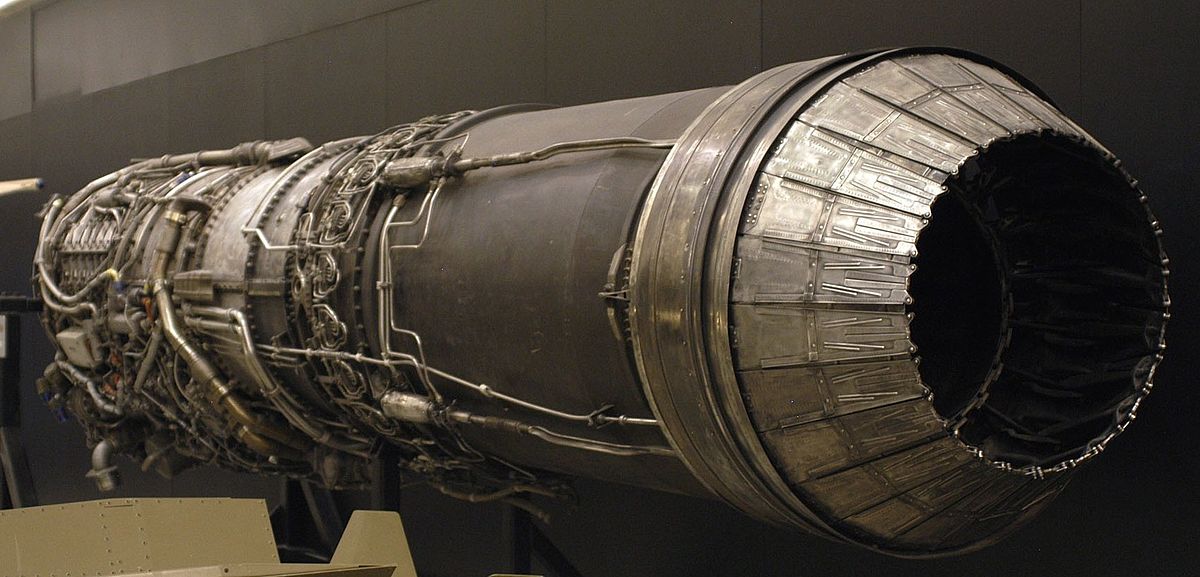
General Electric J79 - Wikipedia
Turboréacteur SNECMA ATAR 09K50
1020 mm
992 mm (= 0.992 m)
BLACK_MAMBA
ACCESS: Secret
- Joined
- 17 July 2019
- Messages
- 382
- Reaction score
- 879
Not quite Archibild....In fact I've just realized that (AFAIK) it was actually never done. Mirage IIIO did it for the Avon, but no such swap was ever done for the J79.
I mean, rolling a J79 in place of an Atar in a second-hand (not NEW BUILD) Mirage airframe.
Before IAI did the Kfir they converted one Mirage IIIBJ to use a J79. Not a production airframe I know, but it could be done. The same airframe was tested later with canards fitted too.
Attachments
BLACK_MAMBA
ACCESS: Secret
- Joined
- 17 July 2019
- Messages
- 382
- Reaction score
- 879
Here is something very interesting. The same Mirage IIIBJ modified with a J79 and canards from post #93 was also equipped with leading edge slats somewhere in its flight test life. I can only assume this must have been in aid of FBW development for Lavi?
Attachments
The Atar few advantages are: rock-solid and reliable (compared to F-104 J79s: I've read some horror stories about it on this very forum recently) rugged and easier to cool.
And smokeless… big advantage for the Atar in combat.
(Here’s some F-104s with J79 flying formation with a Mirage IV with Atar)
Last edited:
Here is something very interesting. The same Mirage IIIBJ modified with a J79 and canards from post #93 was also equipped with leading edge slats somewhere in its flight test life. I can only assume this must have been in aid of FBW development for Lavi?
I vaguely remember reading somewhere it was called the "technolog"...
NoBarrelRolls
"C'mon Mav! Do some of that pilot s#!t!"
Hello, good afternoon to everyone.
I am writing to you because I found this photo and as my French is not very good, I translated the subtitles as best I could and the truth is that I had no idea about that this prototype existed.
Does anyone have any more information about this Mirage III C2 No. 01 Atar 9K50?
The translation of the subtitles:
"The Mirage IIIC2 nr 01 during presentation at Bourget. This prototype, that was used to test the Atar 9k50, had a fuselage closer to that of the IIIO than to the IIIC. Tests were done at Villaroche between october and december 1965."
Thank you very much in advance


I am writing to you because I found this photo and as my French is not very good, I translated the subtitles as best I could and the truth is that I had no idea about that this prototype existed.
Does anyone have any more information about this Mirage III C2 No. 01 Atar 9K50?
The translation of the subtitles:
"The Mirage IIIC2 nr 01 during presentation at Bourget. This prototype, that was used to test the Atar 9k50, had a fuselage closer to that of the IIIO than to the IIIC. Tests were done at Villaroche between october and december 1965."
Thank you very much in advance
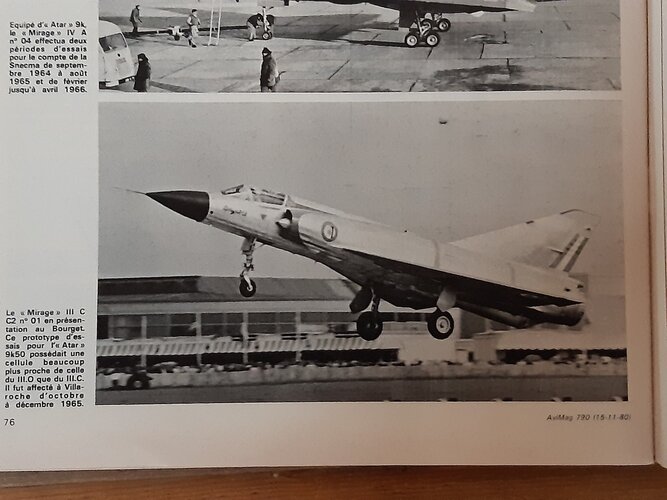
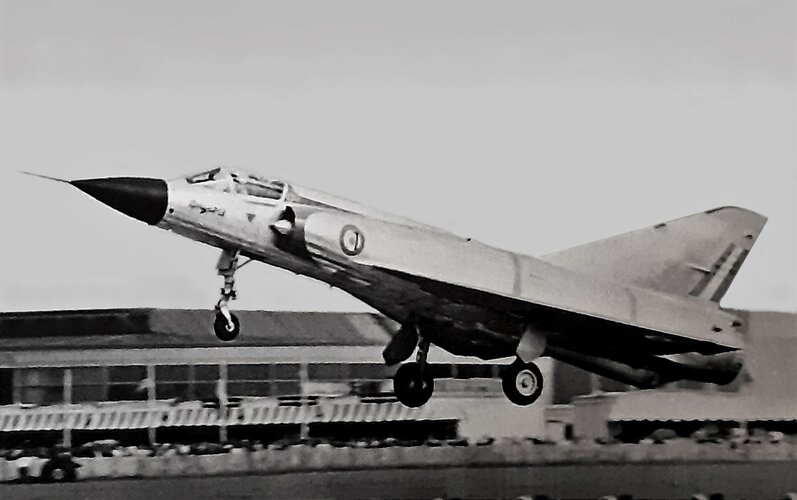
A modified Mirage IIIE, or so it seems.
Seems it was the first, ever, Mirage that got an Atar 9K (rather than a 9C) - developed for the Mirage IV; not yet the 9K50.
Long story short: the 9K Atar was developed, first, for the Mirage IVA. Over the 1960's it gradually evolved into the final 9K50, with intermediate variants: 9K-6, 9K-31.
Thrust was gradually improved, kind of "1000 pounds at a time" (450 kg)
9C: 6200 kg
9K: 6700 kg
9K50: 7200 kg
That peculiar Mirage IIIE was used as a 9K testbed for the coming Mirage F1.
Later the Milan and Mirage 50 also got the Atar 9K 50.
Last edited:
I like Mirage IIIT :
Looks like a Mirage III with a Mirage 2000 shape !
Radium
Yes, but the TF106 was a piece of junk. Like most of that Pratt turbofan family, btw.
I like Mirage IIIT :
Looks like a Mirage III with a Mirage 2000 shape !
Radium
Yes, but the TF106 was a piece of junk. Like most of that Pratt turbofan family, btw.
I am not an expert of american engines. But from what I know, F100 and F110 engines are really nice !
By the way :
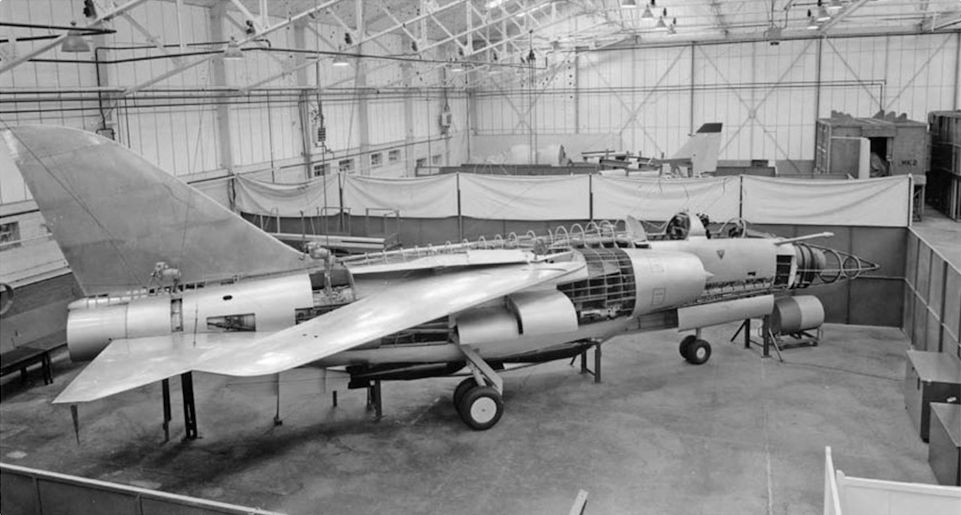
Direct derivative from Mirage G series, but as a French/British future aircraft project.
TF104, TF106, TF30, TF306 are the generation before - Pratt's F-111 & Tomcat turbofans. My understanding is, that family of engines was created in the late 1950's as the first military turbofans - for the subsonic F6D Missileer.
When it was canned and the long range fleet interceptor became the F-111B & Tomcat, Pratt accordingly turned its engine supersonic: and failed miserably. The TF104 / TF30 family was marred by endless compressor stalls that killed way too much pilots until 2006 and the Tomcat retirement.
The engine was kind of controversial its entire run.
SNECMA had been in a deal with Pratt in 1959 to get J75s for the Mirage IV on steroids - the IVB. It went nowhere, but SNECMA used the deal to get TF104 / 106 / TF30 licence is 1963 for future Mirages - VSTOL, swept wing, VG wing all flew with that engine. SNECMA seemingly managed to correct a few TF30 flaws Pratt failed to correct.
TBH, the whole story is rather convoluted and I probably got it wrong.
TF30 problems were linked to the F-111 own troubles.
When it was canned and the long range fleet interceptor became the F-111B & Tomcat, Pratt accordingly turned its engine supersonic: and failed miserably. The TF104 / TF30 family was marred by endless compressor stalls that killed way too much pilots until 2006 and the Tomcat retirement.
The engine was kind of controversial its entire run.
SNECMA had been in a deal with Pratt in 1959 to get J75s for the Mirage IV on steroids - the IVB. It went nowhere, but SNECMA used the deal to get TF104 / 106 / TF30 licence is 1963 for future Mirages - VSTOL, swept wing, VG wing all flew with that engine. SNECMA seemingly managed to correct a few TF30 flaws Pratt failed to correct.
TBH, the whole story is rather convoluted and I probably got it wrong.
TF30 problems were linked to the F-111 own troubles.
Intersting.TF104, TF106, TF30, TF306 are the generation before - Pratt's F-111 & Tomcat turbofans. My understanding is, that family of engines was created in the late 1950's as the first military turbofans - for the subsonic F6D Missileer.
When it was canned and the long range fleet interceptor became the F-111B & Tomcat, Pratt accordingly turned its engine supersonic: and failed miserably. The TF104 / TF30 family was marred by endless compressor stalls that killed way too much pilots until 2006 and the Tomcat retirement.
The engine was kind of controversial its entire run.
SNECMA had been in a deal with Pratt in 1959 to get J75s for the Mirage IV on steroids - the IVB. It went nowhere, but SNECMA used the deal to get TF104 / 106 / TF30 licence is 1963 for future Mirages - VSTOL, swept wing, VG wing all flew with that engine. SNECMA seemingly managed to correct a few TF30 flaws Pratt failed to correct.
TBH, the whole story is rather convoluted and I probably got it wrong.
TF30 problems were linked to the F-111 own troubles.
As I said, I am no way an expert of USA engines. At least, I know that F-16 and F-15 series work really well !
I asked the question here. Wanna know what was wrong with that family of turbofans.
Manuducati
ACCESS: Secret
- Joined
- 25 November 2020
- Messages
- 332
- Reaction score
- 1,065
I am not an expert of american engines. But from what I know, F100 and F110 engines are really nice !
The F110 is from General Electric, not Pratt & Whitney.
As I said, I am no way an expert of USA engines. At least, I know that F-16 and F-15 series work really well !
Well, early F100 engines had their fair share of problems. In fact, P&W was quite slow to improve them: coincidentally, they did when the GE F110 became available for F-16s and proved to be the preferred choice of many users.
- Joined
- 3 September 2006
- Messages
- 1,475
- Reaction score
- 1,471
How coincidental !In fact, P&W was quite slow to improve them: coincidentally, they did when the GE F110 became available for F-16s and proved to be the preferred choice of many users.
Marx disagrees, but there's nothing like a little competition to incite progress.
Mirage III-NG and Mirage III-EX were the ultimate Mirage developments in 1982 and 1988, respectively. Funny to think of the III-NG as influenced by the 2000 (analog FBW) while the III-EX would be more influenced by the F1 (that nose and refueling boom, plus plenty other goodies).
 www.aerovfr.com
www.aerovfr.com
Cool, managed to find a picture of each, almost from the same angle.


GPP 2021 : Dassault Mirage IIIEX – aeroVFR
Cool, managed to find a picture of each, almost from the same angle.
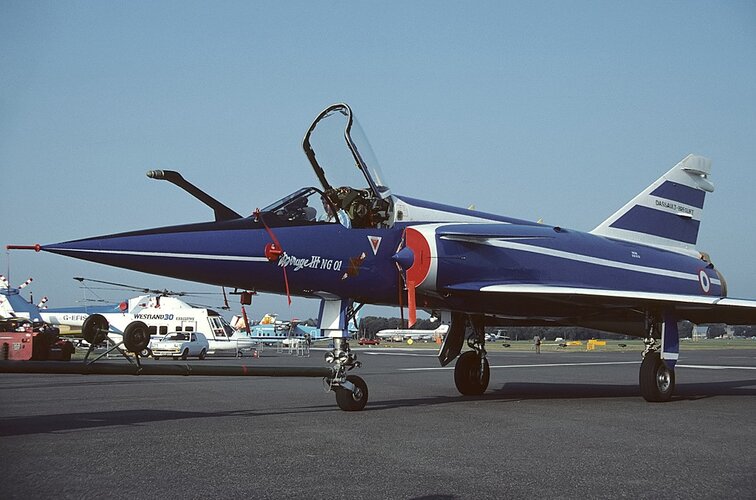
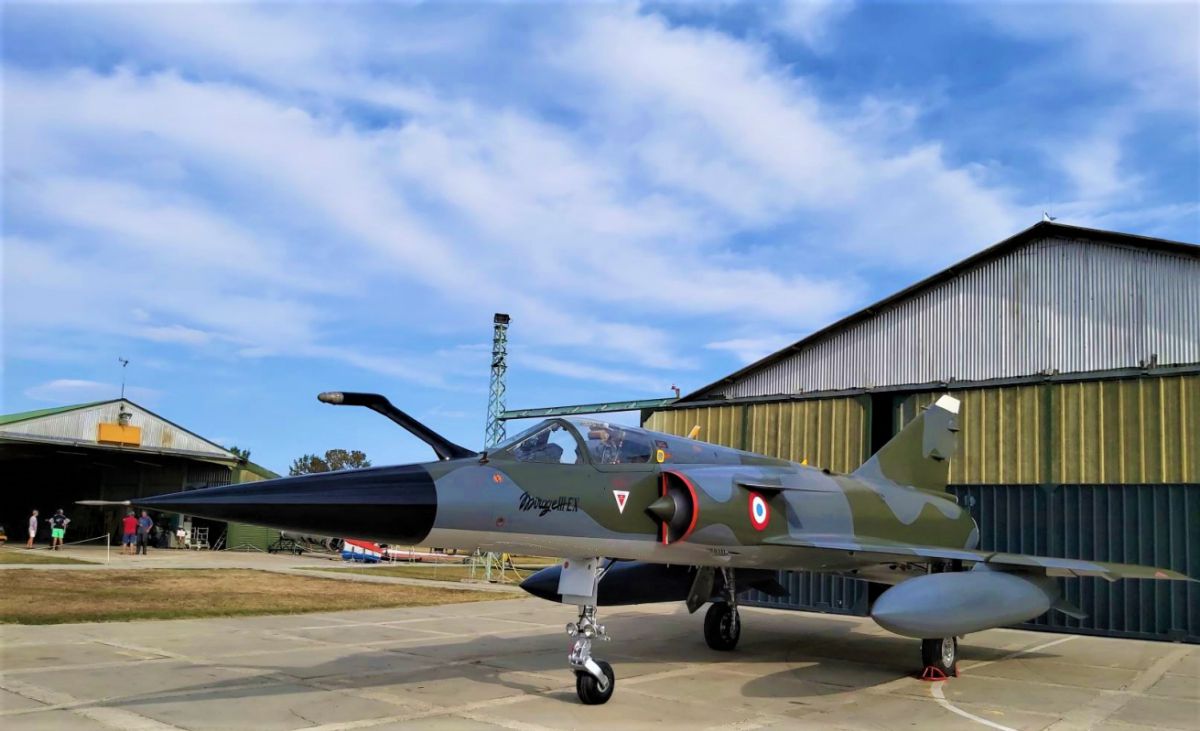
Mirage III-NG once was (during a very long and productive life, 1962-1992 at least)
- Mirage III R n° 301
= Mirage 50 prototype (1979)
= Mirage 50K, with canards (early 1981)
= Mirage III-NG, with the analog FBW (late 1982)
Mirage III-EX started as Mirage IIIE n°467.
- Mirage III R n° 301
= Mirage 50 prototype (1979)
= Mirage 50K, with canards (early 1981)
= Mirage III-NG, with the analog FBW (late 1982)
Mirage III-EX started as Mirage IIIE n°467.
- Joined
- 30 November 2007
- Messages
- 1,126
- Reaction score
- 592
Would love to see a good three-view drawing with dimensions of the Mirage IIIT too please!I haven't found a 3-view of the IIIT.elmayerle said:Does anyone have a good three-view drawing, with dimensions, of the Mirage IIIT? I want to "clone" the nozzle from a Mirage IIIV kit and model that one.
IIIT's dimensions in 'Mirage III - les monoréacteurs Dassault à aile delta - Tome 3' by Bernard Chenel / Eric Moreau / Michel Liébert, DTU 2008:
Length without probe: 15.37 m
Span: 8.48 m
Height: 4.60 m
Weight empty: 7870 kg
Take off weight: 11230 kg
- the Mirage IIIT used a modified IIIE-wing
- starting from frame 19, its fuselage was fatter than the IIIE's - 40 frames in total
- inlet shock-cones were at a downward angle of 25o
- 18 dm2 airbrakes instead of the IIIE's 13 dm2 airbrakes
At some time Mirage IIIT-01 was on display as a gate guard at Base Aérienne 721, Rochefort. It might still be there.
Sideview from http://pics-aeronef.discutfree.com/t3699-mirageiii
Gate guard view from http://aeronantesspotters.forumactif.com/t572-meeting2011-ba721-rochefort-meeting-de-l-air
Terry (Caravellarella)
Does anyone know the details on the FAA Mirage 5P MARA avionic upgrade suite? There were unverified reports that the early MARAs used the Omega VLF navigation system, Canadian Marconi's flight computer, radar altimeter, multi-mode radar, and RWR. There were reports that a commercial GPS by Garmin was eventually added to supplement legacy navigation systems.
Deltafan
ACCESS: Top Secret
- Joined
- 8 May 2006
- Messages
- 1,697
- Reaction score
- 2,317
I do not have a three-view drawing of this aircraft in my files, but in this book: https://www.amazon.fr/monoréacteurs-Dassault-aile-delta-Mirage/dp/2912749107Would love to see a good three-view drawing with dimensions of the Mirage IIIT too please!I haven't found a 3-view of the IIIT.elmayerle said:Does anyone have a good three-view drawing, with dimensions, of the Mirage IIIT? I want to "clone" the nozzle from a Mirage IIIV kit and model that one.
IIIT's dimensions in 'Mirage III - les monoréacteurs Dassault à aile delta - Tome 3' by Bernard Chenel / Eric Moreau / Michel Liébert, DTU 2008:
Length without probe: 15.37 m
Span: 8.48 m
Height: 4.60 m
Weight empty: 7870 kg
Take off weight: 11230 kg
- the Mirage IIIT used a modified IIIE-wing
- starting from frame 19, its fuselage was fatter than the IIIE's - 40 frames in total
- inlet shock-cones were at a downward angle of 25o
- 18 dm2 airbrakes instead of the IIIE's 13 dm2 airbrakes
At some time Mirage IIIT-01 was on display as a gate guard at Base Aérienne 721, Rochefort. It might still be there.
Sideview from http://pics-aeronef.discutfree.com/t3699-mirageiii
Gate guard view from http://aeronantesspotters.forumactif.com/t572-meeting2011-ba721-rochefort-meeting-de-l-air
Terry (Caravellarella)
for the dimensions, there are :
-Length (without the pole) : 15,37 m (with PW TF104 B. It is not specified if the length changes with the installation of the TF106A3, which is a TF104 with one more stage at the low pressure compressor)
-wingspan : 8,48 m
-height : 4,60 m
Nothing in this one (which I do not have)? https://www.secretprojects.co.uk/threads/prototypes-expérimentaux-dassault-1960-1980.30225/
Last edited:
- Joined
- 1 April 2006
- Messages
- 11,390
- Reaction score
- 10,278
Racing, Flying & Yachting including Sale Benefiting Patrouille de France | Sale n°3276 | Lot n°46 | Artcurial
DASSAULT AVIATION MIRAGE III V Maquette, en résine, à l'échelle 1/50ème, en résine, par MEE, montée sur un socle en marbre L : 38 cm. (15 in.) Mirage III V scale model by MEE mounted on a marble base Estimation 700 - 1 000 €
Attachments
Could you expand on the flexible tanks of the Mirage III?Hi everybody,
from the end of the book Mirage III, tome 3 (Chenel, Moreau, Liébert), DTU 2008 (page 405) :
MD 600 project from 1968 with one M53 or J79 engine (25 to 39% more power, 15 to 20% less consumption) :
-Mirage III frame but with integrated tanks (like the Mirage F1 and no more the flexible tanks of the Mirage III) : more kerosene
[...]
BLACK_MAMBA
ACCESS: Secret
- Joined
- 17 July 2019
- Messages
- 382
- Reaction score
- 879
The fuel tanks of the Mirage III are a rubber bladder that fits in the corresponding place inbetween the aircraft structure within which the fuel is kept. The structure itself thus just supports the shape of this bladder fuel tank - it being flexible. The F1 did away with the rubber bladder and went to sealed "compartments" creating its fuel tanks within the aircraft structure. It is one of the ways through which the F1 increased its internal fuel capacity over the III - by eliminating the need for bladder and "simply" sealing the tank area off.Could you expand on the flexible tanks of the Mirage III?
F.L.
ACCESS: Top Secret
Similar threads
-
Early Mirage III competitors (1953-1956)
- Started by Archibald
- Replies: 11
-
Unbuilt & Prototype Mirages 1955-1980
- Started by Archibald
- Replies: 229
-
-
-
French New Interceptor Competition of 1953 & Its contenders
- Started by hesham
- Replies: 1

